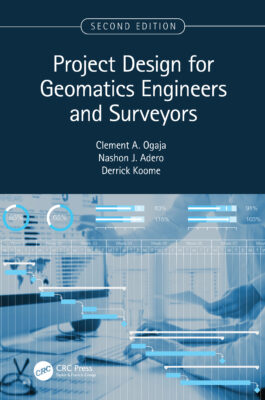
Project Design for Geomatics Engineers and Surveyors, Second Edition has been written by geospatial engineering experts with the goal of helping readers navigate the priority issues when planning new projects. It has been created with a wide audience in mind – undergraduate and graduate students, professors, practicing professionals and surveyors will find it useful, as well as geospatial/geomatics engineers, civil engineers, mining engineers, GIS professionals, planners, land developers, and project managers.
New technology, new edition
The book builds on Geomatics Engineering: A Practical Guide to Project Design, released in 2010, but it is thoroughly updated to keep current with the recent technology and terminology. It includes also new materials on surveying and UAV.
The two new chapters capture new developments in the rapidly emerging use of remote sensing and GIS in aerial surveys, mapping, and imaging for small-to-medium scale projects, as well as modern practices and experiences in engineering surveying.
The new edition provides a simple guide for geomatics engineering projects using recent and advanced technologies, including new content on spatial data collection using GIS, drones, and 3D digital modelling.
As well as practical considerations, such as scheduling and budgeting, it also covers professional standards; professional and ethical responsibilities; and policy, social, and environmental issues.
Navigating new projects
Dr Clement Ogaja, one of the book’s authors, said: “The goal of this second edition is to build on the first edition with the theme of project design processes, professionalism, and pertinent issues, and not necessarily on the theory of topical areas of the geomatics discipline.
The key components and aspects of project design for geomatics and land surveying projects are presented with the goal of helping the reader navigate the priority areas of attention when planning new projects.
It guides readers through the project design and request for proposal process commonly used for soliciting professional geomatics and land surveying services.”
Project Design for Geomatics Engineers and Surveyors, Second Edition is available from 23 March from CRC Press, and is available worldwide.
Further Information
Project Design for Geomatics Engineers and Surveyors, Second Edition
By Clement Ogaja, Nashon Adero, Derrick Koome
Published March 23, 2023
303 Pages
eBook: 9781003297147 | £80.99 |
Hardback: 9781032266794| £90 |
About The Authors
Clement A. Ogaja has worked in various capacities as a professor, researcher, and geodesist in the United States, Australia, and Kenya. He earned a B.Sc. in Surveying from the University of Nairobi in 1997 and a Ph.D. in Geomatics Engineering from UNSW Sydney, Australia, in 2002. In addition to his three books, Geomatics Engineering: A Practical Guide to Project Design (CRC Press), Applied GPS for Engineers and Project Managers (ASCE Press), and Introduction to GNSS Geodesy: Foundations of Precise Positioning Using Global Navigation Satellite Systems (Springer), he is author and co-author of several research papers published in international scientific journals and conference proceedings. He has extensive experiences in education, research and private industry having worked for Geoscience Australia, California State University, Topcon Positioning Systems, NOAA’s National Geodetic Survey and as a land surveyor with Aerophoto Systems Engineering Company in Kenya. Dr. Ogaja’s primary interest is researching the applications of GPS/GNSS and Geomatics technologies to solving engineering and societal problems.
Nashon J. Adero, a lecturer at Taita Taveta University, Kenya, is a geospatial and systems modelling expert. He teaches core units of Engineering Surveying, Mine Surveying and GIS, and support courses in facility management, sustainability, communication in science and engineering, and research methodology. He has acquired extensive cross-sector experience as a tunnel surveyor, a GIS manager, and a lead consultant for government agencies and private organizations. He also trained and worked as a policy analyst at the Kenya Institute for Public Policy Research and Analysis (KIPPRA), under a postgraduate training program in economic modeling and public policy research and analysis. His doctoral research at the Technical University and Mining Academy at Freiberg focused on mining surveys and geospatial models for mine planning. He earned an M.Sc. in Resources Engineering from Karlsruhe Institute of Technology (KIT) in 2006 and B.Sc. (Hons.) in Surveying from the University of Nairobi in 2000. He is author, co-author, and co-editor of articles, books and book chapters, conference proceedings, policy papers, technical reports, and media articles on geospatial technologies, environmental sustainability, decision support models, and skills development. In 2021, he co-edited The Future of Africa in the Post-COVID-19 World, a peer-reviewed book.
Derrick Koome earned a BSc in Geospatial Engineering from University of Nairobi. He has worked in the private sector for 9 years, 7 of which as a freelance surveyor in Kenya and neighbouring countries of Rwanda, Somalia, Somaliland and South Sudan. He is also a Carlson Software centric supplier for the African region and a KCAA (Kenya Civil Aviation Authority) certified UAV pilot. His set of skills is a blend of retail, writing, designing, and surveying. He has written articles that have been featured in leading international magazines such as GIM International, xyHt and xyz Journal of French Association of Surveying.
About Taylor & Francis
Taylor & Francis supports diverse communities of experts, researchers and knowledge makers around the world to accelerate and maximize the impact of their work. We are a leader in our field, publish across all disciplines and have one of the largest Humanities and Social Sciences portfolios. Our expertise, built on an academic publishing heritage of over 200 years, advances trusted knowledge that fosters human progress. Our 2650 people, based in a global network of offices in 17 countries, use their skills and the latest technology to curate, validate and share impactful advanced, emergent and applied knowledge. Under the Taylor & Francis, Routledge and F1000 imprints we publish 2700 journals, 8000 new books each year and partner with more than 700 scholarly societies. Taylor & Francis is proud to be a Global Certified Accessible™ publisher and our operations and all our print publications are certified CarbonNeutral®.